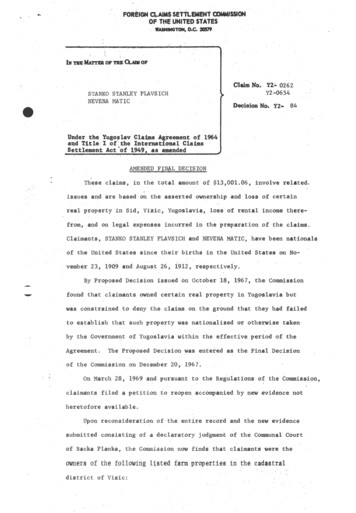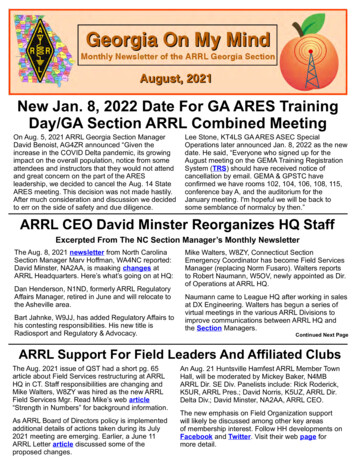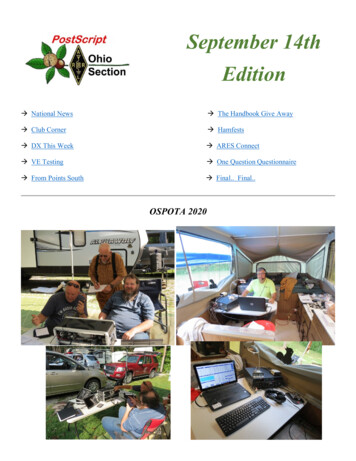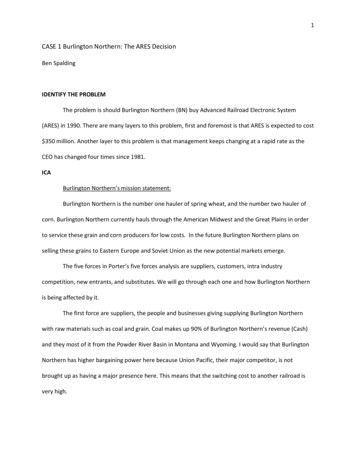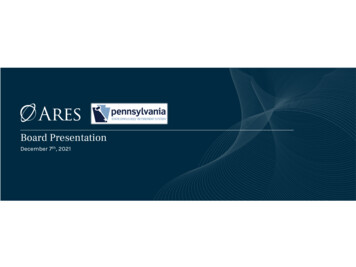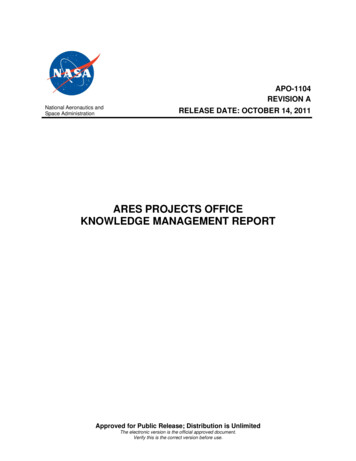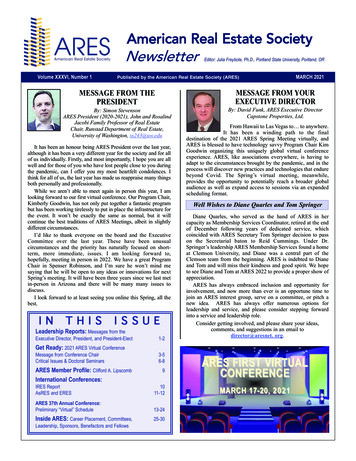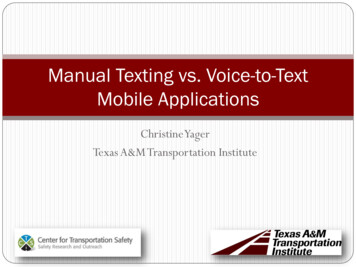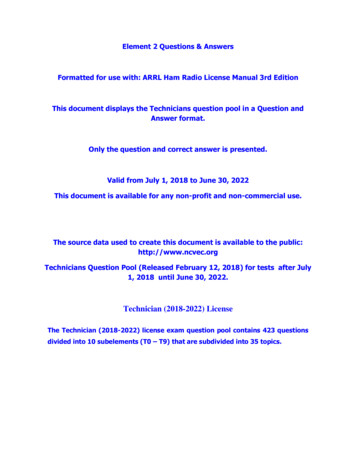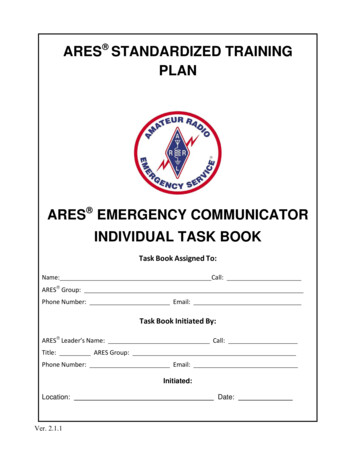
Transcription
ARES STANDARDIZED TRAININGPLANARES EMERGENCY COMMUNICATORINDIVIDUAL TASK BOOKTask Book Assigned To:Name:Call: ARES Group:Phone Number:Email:Task Book Initiated By:ARES Leader’s Name:Title:Phone Number:Call:ARES Group:Email:Initiated:Location:Ver. 2.1.1Date:
ARES Training Plan Task Book Task BookThe Task Book is a working document that enables those ARES communicators electing to participatein the ARRL training plan to track and document their training plan elements as they are completedtowards the various levels of increasing proficiency. The Task Book should contain all training planitems, completion dates and sign-offs as the ARES communicator transitions through the three skilllevels. The ARES communicator is responsible for maintaining his/her Task Book and having it withhim/her during training and assignments. The Task Book also contains sections with definitions of thecommunicator levels, as well as common responsibilities.Since the Task Book is personal to each ARES Communicator, each user should feel free to adapt it totheir needs and requirements of their geographical region.Recommendations of minimum proficiencies and skills per level are listed. ECs, at their discretion, canadd or substitute skills that they consider important. Prior known experience may be substituted forsome listed tasks. It is suggested that items in the proficiency/skills section be used in training sessionsor for meetings/events presentations.NOTE: the approving EC should meet/exceed the qualifications for each level they are signing off on.ADDITIONAL NOTE: At the end of this Task Book is a change log page that communicators should useto keep track of changes to the Task Book.Skill LevelsLevel 1 ‐ Entry level into ARES , includes skills learned when obtaining an Amateur Radio licenseLevel 2 ‐ Set of skills desired by ARES obtained through coursework and trainingLevel 3 ‐ Increased skill set that initiates a pathway to leadership positions and assignmentsResponsibilities:Individual Review and understand Task Book requirementsIdentify desired objectives/goalsSatisfactorily demonstrate completion of tasks for each levelAssure the evaluations are completedMaintain and keep the Task Book up to dateMake Task Book available during assignmentsSubmit completed Task Book to Section ManagementEvaluator Be knowledgeable and proficient in the tasks being evaluated and approvedMeet with Communicator and evaluate past experiences, current qualifications anddesired objectives/goalsReview tasks with CommunicatorDocument completion of tasks with Task Book sign-off’s Ver. 2.1.1
SectionVer. 2.1.1 Complete the sign-off, comments and qualifying Maintain database for ARES participants in ARES Training Plan
ARES STANDARDIZED TRAINING PLAN TASK BOOKNAME:CALL:LICENSE CLASS:HOME GROUP:DATE:ARES TRAINING LEVELLevel 1This is the primary level for those who choose a non-leadership role as well as those new to Amateur Radio or emergencycommunications. This introductory training is conducted by the local ARES group to meet its needs and those of its served agencyor partners. This training could be formal or informal and would introduce the ARES participant to the fundamentals ofemergency communications and provide instructions on how participants are to conduct themselves while serving in the field orotherwise activated. Participants are encouraged to complete Level 1 and advance to level 2 as soon as practical.R Required, O Optional, E - Intro to Incident Command System*OIS-700.b Introduction to National Incident Mgt. System*OSKYWARN - Spotter Basic Training (Biennially)OARRL EC-001 Introduction to Emergency CommunicationsOComment: *Sets initial baseline requirements. Will likely be insufficient for deployment at an incident.ParticipationObtain Task BookRJoin an ARES groupRComment:Proficiency/SkillObtain Technician class or higher Amateur Radio LicenseComment:Attach Copy of FCC License Here:Ver. 2.1.1REC Sign Off
ARES STANDARDIZED TRAINING PLAN TASK BOOKNAME:CALL:HOME GROUP:LICENSE CLASS:DATE:Level 1 Completion RecordThe listed tasks for the level 1 having been completed, dated and initialed indicate successfulcompletion of all the tasks required of the ARES Communicator for the Level 1.The individual is recommended as certified for this level.Date:Comments:Ver. 2.1.1EC
ARES STANDARDIZED TRAINING PLAN TASK BOOKNAME:CALL:LICENSE CLASS:HOME GROUP:DATE:ARES TRAINING LEVELLevel 2This training level builds upon what has been learned in Level 1, and participants in Level 2 may elect to remain at this level based uponthe extent of their desired ARES involvement. Much of this training is conducted by the local ARES group to meet its needs and those oftheir served agency or partners and provides a better understanding of emergency communications. Participants in Level 2 may wish tocontinue with Level 3 and the potential for leadership roles.R Required, O Optional, E EncouragedEducationIS-100.c - Intro to Incident Command System*RIS-200.c – ICS for Single Resource*RIS-700.b – Introduction to National Incident Mgt. System*RIS-800.c – National Response Framework*RARRL EC‐001 Intro to Emergency CommunicationsRSKYWARN Spotter Basic Training (Biennially)OComment: *These should be considered as meeting the minimum requirements for deployment at an Incident. Local EMA authorities may requireadditional training.ParticipationNet Participation (Once per Quarter)RPublic Service Event ParticipationOSimulated Emergency Test or Exercise Participation (Annually)OServe as Net ControlOComment:Proficiency/SkillProgram tone into HTRProgram frequency & offset into radioRWrite and send an ICS‐213 messageROperate VHF Digital messaging stationOOperate unit specific Digital VHF or HF stationOBuild a simple dipole antenna**EBuild Powerpole adapter cable**ESolder PL259 connector to coax**EAssemble a 24-hour Deployment Kit*EComment: * The contents of a 24-hour Kit will be specified in either a separate document or as an Annex to this document.** Skills that are very useful to know and everyone is encouraged to learn.Other /Unit SpecificComment:Ver. 2.1.1
ARES STANDARDIZED TRAINING PLAN TASK BOOKNAME:CALL:HOME GROUP:LICENSE CLASS:DATE:Level 2 Completion RecordThe listed tasks for the Level 2 having been completed, dated and initialed indicate successfulcompletion of all the tasks required of the ARES Communicator for the level 2.The individual is recommended as certified for this level.The individual is in need of additional training as indicated below. (Optional)Date:Comments:Ver. 2.1.1EC or DEC
ARES STANDARDIZED TRAINING PLAN TASK BOOKNAME:CALL:LICENSE CLASS:HOME GROUP:DATE:ARES TRAINING LEVELLevel 3Level 3 prepares the participant to take on ARES Team leadership roles in his/her ARES group or section.R Required, O Optional, E EncouragedTASKR-O-ECOMPLETIONDATEEC or DECSign OffEducationIS-120.c - An Introduction to Exercises*RIS-230.d - Fundamentals of Emergency Management*RIS-235.c - Emergency Planning*RIS‐240.b ‐ Leadership & Influence*RIS-241.b - Decision Making & Problem Solving*RIS-242.b - Effective Communications*RIS-244.b - Developing & Managing Volunteers*RIS-288.a – Role of Voluntary organizations in Emergency Mgt*.RIS-2200 - Basic Emergency Operations Center Functions*RARRL EC-016 Public Service & Emergency Communications Mgt*RSKYWARN Advanced Training Class (Biennially)OPR‐101 – Public Information Officer Training (EC‐015)OAUXCOM CourseOICS-300 - Incident Command System for Expanding Incidents**ICS -400 - Advanced Incident Command System**OOComment: * Required for those seeking/holding leadership positions. These individuals should also hold a General Class (or higher) Amateurlicense.** Participants are encouraged to complete the FEMA courses ICS-300 and ICS-400 when they become available locally.ParticipationNet Participation (Once per Quarter)RPublic Service Event Participation (Annually)RSimulated Emergency Test or Exercise Participation (Bi‐Annually)RServe as Net ControlRComment:LeadershipPresent a training sessionRHold/held a leadership position in a groupRHold a General Class License or higherOParticipate in PIO activities (PR‐101 Qualifies)REC-001 Course Instructor/MentorOVer. 2.1.1
ARES STANDARDIZED TRAINING PLAN TASK BOOKNAME:CALL:LICENSE CLASS:HOME GROUP:DATE:Comment:Proficiency/SkillProficient in using ICS formsROperate VHF Digital messaging station in Peer‐to‐peer modeROperate HF Digital Mode Messaging StationRProgram Tone into HTRProgram frequency & offset into radioRDemonstrate cross band repeat on Mobile Radio (UHF VHF)OLevel 3 Completion RecordThe listed tasks for the Level 3 having been completed, dated and initialed indicate successfulcompletion of all the tasks required of the ARES Communicator for the level 3.The individual is recommended as certified for this level.The individual is in need of additional training as indicated below. (Optional)Date:Comments:Ver. 2.1.1EC or DEC
NAME:CALL:HOME GROUP:LICENSE CLASS:DATE:ARES SECTION/UNIT SPECIFIC TRAINING REQUIREMENTSALL LEVELSThis page is for listing of additional tasks as may be required by ARES units for their specific needs.R Required, O Optional, E t:LeadershipComment:Proficiency/SkillComment:Ver. 2.1.1LEVELR-O-E 1‐2‐3COMPLETIONDATEECSign Off
Attach Copy of FEMA/NIMS ICS Course Transcript Here:Ver. 2.1.1
Common Responsibilities (for Activations)It is the responsibility of each ARES Communicator to be prepared with the proper dress,equipment, knowledge, and demeanor to support the assigned task. If you are unable to performor uncomfortable with your assignment, let your Team Leader or requesting agency know so thatyou may be assigned appropriately.At StagingComplete and turn in forms and check in at Staging AreaObtain briefing from Agency Lead or Resource Team Leader regarding incident/eventReceive Job assignment, reporting location and travel instructionsVerify equipment needed for assignmentObtain Frequency Plan (ARES Frequency Plan or ICS Form 205)Access personal readiness for incident and climate (physical, clothing, medications,money, equipment guides, etc.) Maintain a check list of your equipment and personal “Go‐Kit” Inform others as to where you are going and how to contact you Review your Operations and Procedures Notebook/Documentation At Assignment Check in with the on‐site leader or agency officialCheck in with Net Control to inform you are on siteDetermine location to set up equipmentSet up your equipment with safety in mindEstablish radio contact with net control per frequency planPrepare and maintain reports and forms for your taskUse clear text and ICS terminology in all radio communications (no codes)Be mindful of HIPPA concernsCarry out assignments as directedAt end of shift or demobilization Brief relief communicator on ongoing operations when relievedRetrieve all personal gear and return your area to pre-arrival conditionCheck out with net control or return to staging areaReport to Staging Area for R&R, reassignment or deactivationParticipate in after action activities as directedCommunicators may want to maintain personal log of actions and eventsTeam Leader ResponsibilitiesReview common responsibilitiesParticipate in incident meetings and briefings as requiredDetermine status of unit activitiesDetermine resource needsOrder additional resources as neededProvide unit with status updates and reportsAssign specific dutiesMaintain personnel accountability statusMonitor safety and security of unitSupervise demobilization Collect and maintain all unit records and forms
Release1.2.11.2.11.2.11.2.12.1.02.1.1Date Change ange Log EntryRemoved IS-775 course from Level 3Added IS-2200 in Level 3Removed IS-802 course from Level 3Changed bi-annually to biennially where foundNew version 2.1.0 replaced ver. 1.2.1 on ARRL webpageMade multiple changes to field namesChange Type: Fix, Change, Replace, Removal, addVer. 2.2.0 (DRAFT)
ARES Training Plan Task Book . Task Book. The Task Book is a working document that enables those ARES communicators electing to participate in the ARRL training plan to track and do
